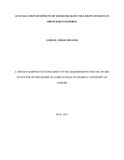| dc.description.abstract | During the period after the adoption of a floating exchange rate regime in Kenya, there has been
substantial volatility produced by the regime. In spite of the considerable foreign exchange
contribution of Kenya’s French bean subsector to the economy, the effects of exchange rate
volatility on it remains unclear. This study evaluated the effects of exchange rate volatility on
Kenya’s French bean exports to major markets in the European Union using monthly secondary
data for the period January 1990 to December 2011. The specific objectives of the study were to
assess the trends in the volatility of Kenya’s exchange rate, quantify the effect of exchange rate
volatility on French bean exports and evaluate the effect of shilling exchange rate liberalization
on exports of French bean in Kenya. In evaluating exchange rate volatility, the study employed
the generalized autoregressive conditional heteroscedasticity model. An export demand model
was used to assess the effects of exchange rate volatility and liberalization on French bean
exports. The empirical results show a negative effect of exchange rate volatility on French bean
exports and a stimulation of exports by a shift in the exchange rate regime from fixed to floating.
An increase in the level of income in importing countries led to a rise in the volume of Kenya’s
French bean exports while an increase in the relative price led to a decrease in demand in the
European Union. From these results, the study recommended that policy makers need to
maintain a robust exchange rate regime that will ensure a non-volatile behaviour. Policy
measures aimed at mitigating the high exchange rate volatility to promote French bean exports
from Kenya need to be instituted. The stability of the exchange rate is required by controlling
exchange rate volatility using the exchange rate target band. By means of the exchange rate
target band, there will be no government intervention as long as the exchange rate falls within
the tolerance zone and market forces will determine the exchange rate. However, as soon as the
xii
exchange rate moves above or below the set limits, the government should cease to allow the
exchange rate to float freely and intervene to move the price of the currency within the target
zone. In order to cushion exporters from high exchange rate volatility, the government could set
up a French bean export stabilization facility. The fund could be capitalized by charging
exporters a tax so that during periods of high French bean prices and high export earnings, the
country would accumulate the fund which it would draw down during periods of low French
bean prices. The French bean price stabilization fund would be introduced by the government
through imposition of a tax on exports. This fund would ensure predictability in French bean
prices so that fluctuations would not affect French bean exporters drastically in future. There is
need for policy makers to work towards increasing the volume of exports through diversification
of market destinations by targeting local, regional and export markets as opposed to the current
practice. This can be realized through regional and export market promotion initiatives as well as
consistent compliance with quality standards. Innovative ways of meeting the standards and
facilitation of smallholder farmers to meet these standards is required. In addition, French bean
export promotion incentives such as input subsidies and tax concessions need to be considered.
To limit over-reliance on exports as a major channel for French bean produce in Kenya, the
government and key stakeholders in the industry need to be proactive in promoting utilization of
French bean locally through value addition and creating awareness among local consumers on
the nutritive value of the vegetable coupled with research and extension initiatives. To reduce the
relative price of French bean exports from Kenya, there is need for structural reforms that
contribute to increased productivity and the enhancement of international competitiveness | en_US |

